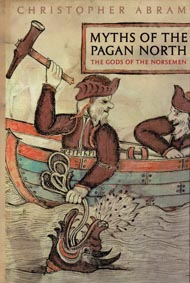Myths of the Pagan North
The Gods of the Norsemen
Christopher Abram
Continuum International Publishing Group, 2011
The Norse myths make up one of the world's great mythologies, and their
popularity shows no sign of diminishing in the twenty-first century. The deeds
and personalities of gods like Odin, Thor and Loki continue to fascinate readers
and to inspire authors and artists in a wide range of genres and media. Many
books about Norse mythology are already available - ranging from retellings
of the myths to comprehensive descriptive handbooks to detailed, painstaking
academic works. This book is designed to introduce the myths to a non-specialist
readership in a new way, and to encourage people who are already familair with
the Norse myths to think about them differently.
Myths of the Pagan North is a history of myth-making in medieval Scandinavia.
My aim is to establish as far as possible when people created these powerful stories
about the pagan gods of the North; why they did so - what religious, social,
or cultural impulses have shaped the myths; and how the myths came into being.
The main theme of this book, then, is the way that myths change in time and space;
how they evolve to meet the needs and desires of the people who make them.
Its structure is roughly chronological. To begin with, we will examine
the different types of sources that contain Norse myths or which may help us
to understand their origins. The second chapter provides a brief overview of
Scandinavian pagan religion, since mythology always has connections to people's
beliefs, even if those connections are not always as straightforward as we might
think. Then, we will trace the history of the myths themselves in the works of
poets from the Viking Age through the era of conversion, and into the work of
learned writers in the Christian period.
My book, therefore, is as much about myths about Norse paganism as it is
about pagan myths - the myths produced by those people whom we can identify
as pagans, who lived in a primarily pagan society and exhibited a pagan worldview.
It is about how the Norse myths changed over time, as religion and society
developed, and as paganism co-existed with and then gave way to Christianity.
But it is also about how medieval Christian attitudes towards pagan religion
have shaped 'pagan' myth. Norse mythology may deal with stories, themes, and
subjects that are ancient, widespread, and eternal, but the Norse myths have never
stood still. They form a dynamic network of belief and narrative, not a static
monument to a lost civilization. Myth is eternal, but it never stops changing.
Christopher Abram is Lecturer in Medieval Scandinavian Studies at University College London.
He did his PhD in the Department of Anglo-Saxon, Norse and Celtic at Cambridge and now specialises
in Old Norse literature and mythology. Myths of the Pagan North is his first book, and in
writing it he has been much influenced by his experience of teaching and discussing Norse mythology
with students at UCL.
(The text above comes from the intro and the back of the book)



